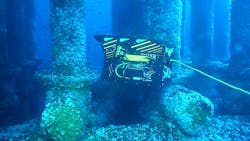Autonomous inspection drone prepares for trials offshore Norway
Offshore staff
Over the next few months, the company will perform offshore trials of the drone as part of its annual inspection campaign for an operator on the Norwegian Continental Shelf.
Craig Cameron, technology manager with DeepOcean, said, “A rapidly growing amount of subsea infrastructure is placed on the seabed within both the offshore renewables and oil and gas industries. This equipment needs to be inspected regularly.
“We have developed the AID to increase efficiency and accuracy when collecting inspection data. It has the potential to substantially reduce the cost, time and environmental footprint that is normally associated with subsea inspection work.”
Traditionally, ROVs have inspected subsea infrastructure launched from multipurpose vessels and controlled by ROV operators onboard. Increasingly, DeepOcean and other are developing capabilities to control the ROV from an onshore-based remote operations center (ROC), cutting costs, emissions and HSE risks.
The company views use of an AID to automate parts of the subsea inspection scope as the next step. This could apply to inspection of external and internal production templates, jacket structures and flexible risers.
And in the offshore renewable energy sector, it sees potential to automate the regular inspection of hundreds of similar subsea structures installed for a single project.
“The AID can perform pre-programmed inspections of all subsea assets,” Cameron said. “This means that significant value can be created…when the same inspection scope can be repeated year on year.”
Digital twins of subsea infrastructure can support the process. DeepOcean has developed a digital twin platform in which a model of an AID is controlled, allowing inspection engineers to virtually plan and simulate the route for the inspection scope.
That plan is then exported to the AID from the ROC, with the AID autonomously executing the planned route while a technician simultaneously oversees the operation from the ROC.
Inspection data from the AID and the position of the vehicle is continuously streamed back into the digital twin to ensure data quality and increase situational awareness for the operator, DeepOcean added.
The AID project is a co-development with Argus Remote systems and Vaarst, with funding from AkerBP.
For the program from Edda Fauna, Remota, the joint venture between DeepOcean, Solstad Offshore and Østensjø Group, is using digitalized control systems to allow management of offshore operations from the Remota onshore control center.
The AID is based on a Rover MK2 ROV from Argus, with the latter also responsible for the AID platform and navigation algorithm. DeepOcean is managing the digital twin platform, mission planner software and live view of the AID in operation, while Vaarst’s machine vision camera Subslam 2x provides autonomous navigation and data collection.
The AID, measuring 1.25 x 0.85 x 0.77 m, weighs 320 kg can operate in water depths down to 3,000 m. Sonardyne has supplied its Sprint Navigator mini 4K as the inertial navigation system, with the Norbit WBMS FLS system ensuring live imaging sonar with obstacle tracking and avoidance.
“We look forward to proving that the AID allows autonomous surveys to be carried out, enabling us to collect data in a smarter way, and gain better support for comparisons and changes over time on subsea equipment,” Cameron said.
04.24.2023

